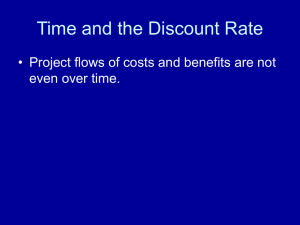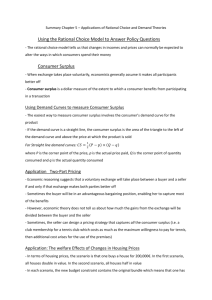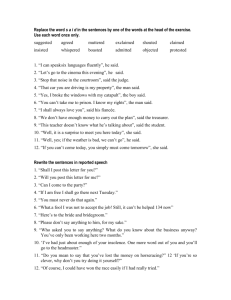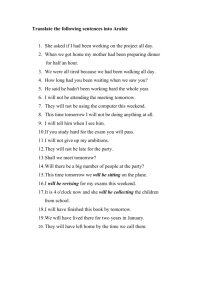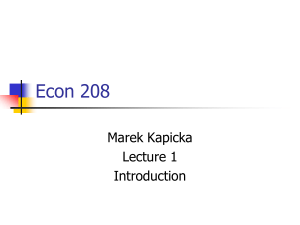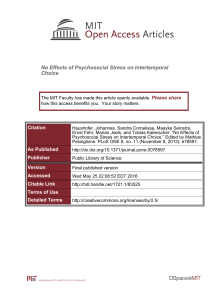Intertemporal choice
advertisement
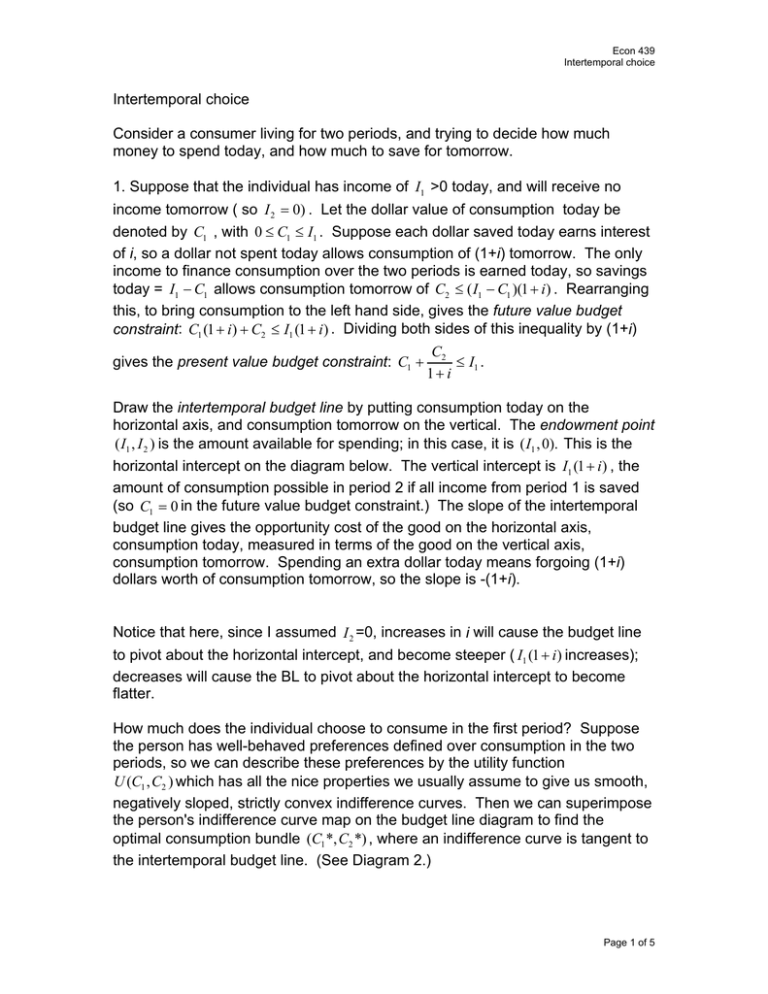
Econ 439 Intertemporal choice Intertemporal choice Consider a consumer living for two periods, and trying to decide how much money to spend today, and how much to save for tomorrow. 1. Suppose that the individual has income of I1 >0 today, and will receive no income tomorrow ( so I 2 = 0) . Let the dollar value of consumption today be denoted by C1 , with 0 ≤ C1 ≤ I1 . Suppose each dollar saved today earns interest of i, so a dollar not spent today allows consumption of (1+i) tomorrow. The only income to finance consumption over the two periods is earned today, so savings today = I1 − C1 allows consumption tomorrow of C2 ≤ ( I1 − C1 )(1 + i ) . Rearranging this, to bring consumption to the left hand side, gives the future value budget constraint: C1 (1 + i ) + C2 ≤ I1 (1 + i ) . Dividing both sides of this inequality by (1+i) gives the present value budget constraint: C1 + C2 ≤ I1 . 1+ i Draw the intertemporal budget line by putting consumption today on the horizontal axis, and consumption tomorrow on the vertical. The endowment point ( I1 , I 2 ) is the amount available for spending; in this case, it is ( I1 , 0). This is the horizontal intercept on the diagram below. The vertical intercept is I1 (1 + i ) , the amount of consumption possible in period 2 if all income from period 1 is saved (so C1 = 0 in the future value budget constraint.) The slope of the intertemporal budget line gives the opportunity cost of the good on the horizontal axis, consumption today, measured in terms of the good on the vertical axis, consumption tomorrow. Spending an extra dollar today means forgoing (1+i) dollars worth of consumption tomorrow, so the slope is -(1+i). Notice that here, since I assumed I 2 =0, increases in i will cause the budget line to pivot about the horizontal intercept, and become steeper ( I1 (1 + i ) increases); decreases will cause the BL to pivot about the horizontal intercept to become flatter. How much does the individual choose to consume in the first period? Suppose the person has well-behaved preferences defined over consumption in the two periods, so we can describe these preferences by the utility function U (C1 , C2 ) which has all the nice properties we usually assume to give us smooth, negatively sloped, strictly convex indifference curves. Then we can superimpose the person's indifference curve map on the budget line diagram to find the optimal consumption bundle (C1 *, C2 *) , where an indifference curve is tangent to the intertemporal budget line. (See Diagram 2.) Page 1 of 5 Econ 439 Intertemporal choice At the optimal consumption bundle, the slope of an indifference curve is just equal to the slope of the budget line. In this particular context, this means that at the optimal consumption bundle, an individual's psychic rate of trade-off between consumption today and consumption tomorrow, given by their rate of time preference, is equated to the market rate of tradeoff, given by the interest rate. What happens to the optimal consumption bundle if i increases? Then consumption today becomes more expensive relative to consumption tomorrow, and the substitution effect says that consumption tomorrow should go up. On the other hand, a given amount of savings today will finance more consumption tomorrow, so an increase in the interest rate makes a person wealthier - the income effect also says consumption tomorrow should go up. What about consumption today? Income and substitution effects work in opposite directions, so the effect is ambiguous. 2. Now suppose that the individual has strictly positive income in both periods. The only change to the analysis above is that the endowment point, E= ( I1 , I 2 ) , is now a point in the positive quadrant rather than on the horizontal axis. Changes in the interest rate will, as before, pivot the intertemporal budget line about the endowment point, but the analysis is slightly more complicated now. The intertemporal budget constraint now includes consideration of the second period positive income. The future value budget constraint is C1 (1 + i ) + C2 ≤ I1 (1 + i ) + I 2 , while the present value version is C1 + C2 I ≤ I1 + 2 . 1+ i 1+ i Consider Diagram 3 below. Here I have assumed positive income in both periods, and allowed for borrowing as well as lending at the common interest rate i. Now the person can be a borrower ( C1 > I1 , C2 < I 2 ) ) or a lender ( C1 < I , C2 > I 2 ) depending on preferences. Consider the indifference curve through the endowment point - this represents the utility the individual would have if they consumed their income in each period, neither borrowing nor lending. If this indifference curve through E is steeper than the budget line, then the individual would be better off borrowing against period 2 income to increase consumption in period 1 - because they have a high rate of time preference (or, some say, are impatient). For this person, the tangency of the budget line and an indifference curve occurs on the budget line below E. Conversely, a person will be a lender if their indifference curve through E is flatter than the intertemporal budget line at point E. Page 2 of 5 Econ 439 Intertemporal choice Now: comparative statics: what can we say about the effects of a change in the interest rate on the amount a person borrows or lends? As in the first case I described, some predictions are ambiguous and some are unambiguous. Suppose at the initial income stream ( I1 , I 2 ) and interest rate i, Rae is a borrower, as in the diagram below, initially consuming at point A= (C1 A , C2 A ) below E on the intertemporal budget line. An increase in the interest rate to i ' > i pivots the budget line through E, making it steeper, with a higher vertical intercept I I ( I1 (1 + i ) + I 2 < I1 (1 + i ') + I 2 ) and a lower horizontal intercept ( I1 + 2 < I1 + 2 ) 1+ i 1+ i' than with the initial interest rate. Notice that bundle A is no longer attainable, since it is outside the new budget set. An increase in the interest rate will induce a borrower to borrow less, and may even turn a borrower into a lender. How does Rae's optimal bundle change when the interest rate decreases? Bundle A is still attainable, but no longer optimal, since it is now inside the budget set. The new optimal bundle will be on the new budget line, and may have increased consumption in both periods. Page 3 of 5 Econ 439 Intertemporal choice Diagram 1 Consumption in pd 2 I1 (1 + i ) (0,0) I1 Consumption in pd 1 Diagram 2 Consumption in pd 2 I1 (1 + i ) (C1 *, C2 *) (0,0) I1 Consumption in pd 1 Page 4 of 5 Econ 439 Intertemporal choice Diagram 3 Consumption in pd 2 I 2 + I1 (1 + i ) E I2 A 0,0 I1 I I 1 + 2 1+ i' I I 1 + 2 1+ i Consumption in pd 1 Page 5 of 5
